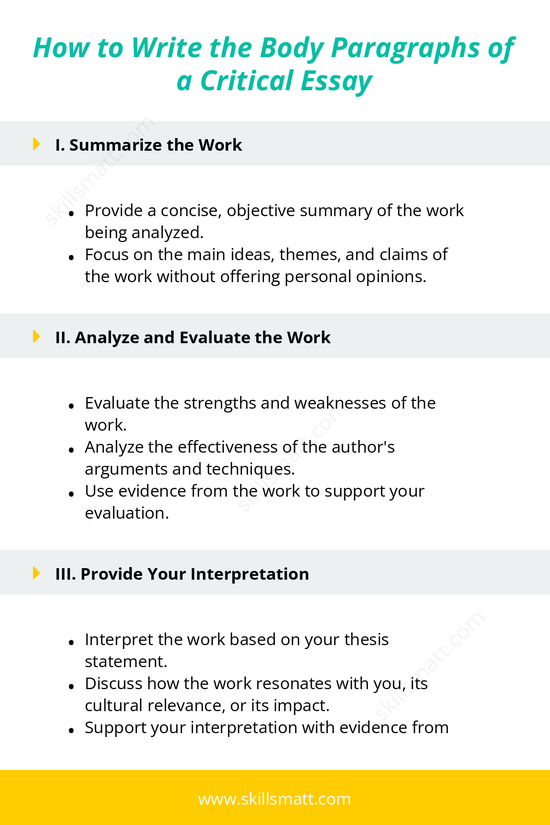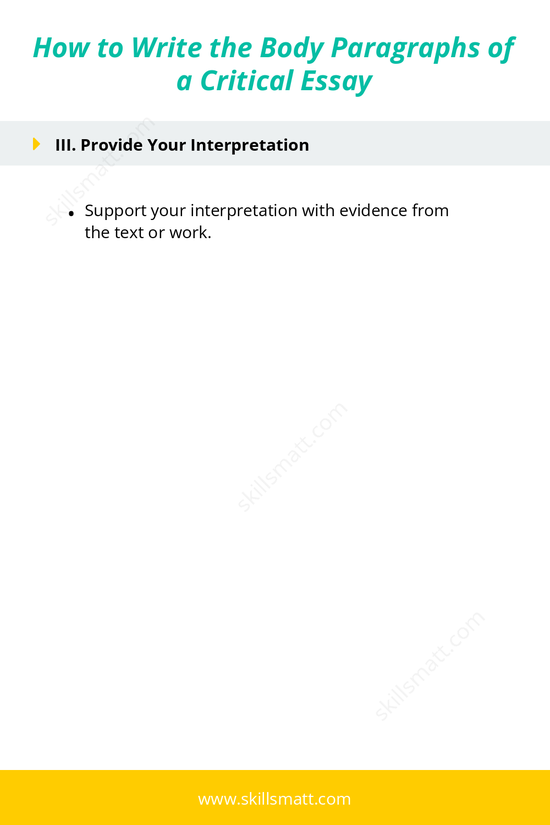How to Write the Body Paragraphs of a Critical Essay
I. Summarize the Work
- Provide a concise, objective summary of the work being analyzed: Begin your body paragraphs by briefly summarizing the work. Ensure that the summary is objective, providing an overview of the key ideas, characters, and events without injecting personal opinion.
- Focus on the main ideas, themes, and claims of the work without offering personal opinions: Keep your summary clear and neutral. Stick to the essential elements of the work—its plot, central themes, and primary claims—without veering into analysis or critique at this stage.
II. Analyze and Evaluate the Work
- Evaluate the strengths and weaknesses of the work: In this section, assess both the positive and negative aspects of the work. Discuss what worked well and what could have been improved. This involves a critical examination of the author's techniques, arguments, and execution.
- Analyze the effectiveness of the author's arguments and techniques: Dive deeper into how effectively the author conveys their arguments or messages. Analyze literary devices, writing style, or structure used to enhance or weaken the work's impact.
- Use evidence from the work to support your evaluation: Support your analysis with concrete examples from the text. This could include direct quotes, specific scenes, or moments in the work that highlight the strengths or weaknesses you've identified.
III. Provide Your Interpretation
- Interpret the work based on your thesis statement: Based on the thesis, provide your interpretation of the work. Explain how it fits into the context of the argument you're making and how it supports your thesis.
- Discuss how the work resonates with you, its cultural relevance, or its impact: Share your personal response to the work. Discuss its emotional or intellectual impact, its relevance to current societal issues, or how it fits within a cultural or historical context.
- Support your interpretation with evidence from the text or work: Provide solid evidence to back up your interpretation. Use direct references, quotes, or scenes that illustrate how your interpretation aligns with the work's themes or messages.
IV. Maintain Smooth Transitions
- Ensure a logical flow between paragraphs by using appropriate transition words and phrases: Transitions are essential to ensure that each paragraph flows naturally into the next. Use transition phrases like 'furthermore,' 'in contrast,' or 'on the other hand' to guide the reader through your argument.
- Make sure each paragraph builds upon the previous one to maintain coherence throughout the essay: Each body paragraph should build logically upon the preceding one. Ensure that the ideas connect seamlessly, allowing your analysis to develop progressively and cohesively.


